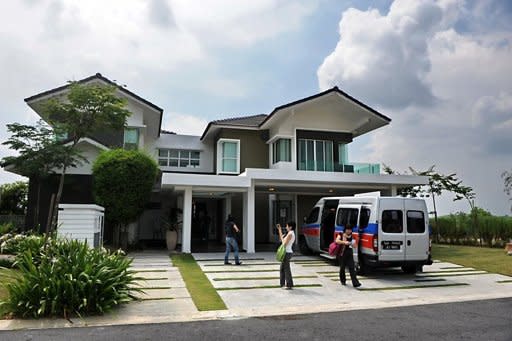A new city taking shape next door

By Seah Chiang Nee
When Singapore launched its plan for a global city of 6.5 million, it sounded like sweet music — rather than a business warning — to businessmen in Johor.
To the forward-looking, this strategy of a wealthy neighbour right next door, which is the 10th most expensive city in the world, spells potential spill-over for their economy.
At a friendly discussion in a hotel, several Malaysians told a Singaporean business consultant that they foresaw two possible scenarios, if Malaysia played its cards right.
That was just after the two governments had signed an agreement over the railway dispute and for future cooperation.
One Malaysian said: "Having a thriving global city next door would allow Malaysia — in particular Johor — to quickly tap onto global trade via Singapore."
Another speaker, a Malaysian researcher, offered this rationale:
"We can also benefit in another way. The Singaporeans are very good at earning foreign exchange — US dollars, Japanese yen and the euro, etc.
"We can earn some of these foreign earnings indirectly from Singaporeans. They are short of things that we have.
"All we need do is offer them a place to come and enjoy themselves."
How Johor could benefit
The feeling was that Singapore was already overcrowded and expensive and it lacked the space for business and fun — and this was where Johor could cash in.
It was nothing new, but the mood was.
It was partially this reasoning that led to the creation of a metropolis, Iskandar Malaysia, in the foothills of southern Malaysia, three times the size of Singapore island.
Last week, as the development pace gathered steam, I could not help but think about the impact it will have on Singapore's economic future.
These news items came within days of one another:
* A tender was opened up for the construction of the Singapore-Johor mass rapid transit or MRT to start operating in 2018.
* A Singaporean billionaire signed a S$2bil deal with the Johor royal family to build a 10ha medical hub and marina city bordering Singapore.
* Southeast Asia's first premium outlet centre will open next month in south Johor, just an hour's drive for Singapore's shopaholics, offering branded products with discounts.
The huge project will be built in stages and will include improved rail, sea and air connections to Singapore (24-hour access) and easier immigration clearance.
Nearly 50 years after their break-up, the two former siblings, who face a gloomy world in the coming year, are pushing the momentum of bilateral cooperation.
Malaysia knows it can benefit from Singapore's world trade links and experience, which date back to early history, to gain promotion to a higher league.
And Singaporeans, who live in the world's 10th most expensive city, can look forward to some relief in their high-cost living.
Actually, it may well bond the two to become more dependent on each other.
For the promised land to be reached, however, requires a few caveats: first, crime and corruption must be put under control and, second, political quarrelling does not upset the applecart.
Crucially important is that the race card is kept away.
Not much interest among Singaporeans?
Still, I am surprised that given the large potential to change lives, the Iskandar concept has stirred little interest among Singaporeans beyond shopping and entertainment at cheaper prices.
The general public, in fact, doesn't have much idea about it. In fact, people here tend to underestimate its potential impact on the future of this trading state.
To the business community, however, Iskandar both serves as a potential partner as well as a strong rival.
It will likely add to the number of rival economies in Asia that are on the verge of overtaking — or have already overtaken — Singapore.
They range from new giants like China and India to smaller developing countries which are aggressively pushing for growth like Indonesia, Malaysia and Vietnam.
Iskandar, for example, is hell bent on attracting foreign investors and establishing a healthcare and an education hub, areas that the republic has been pursuing.
Rivalry aside, the existence of a large metropolis could be a blessing in disguise to help Singapore's dilemma of income inequality.
As more wealthy foreigners settle on this island and pushing prices, the bottom 30 per cent of the poorer class gets increasingly squeezed.
They desperately need a cheaper source of daily living that Johor can provide.
Most important is insufficient and spiralling home prices. Thousands of Singaporeans — with families in tow — who find it hard to cope are buying homes in Johor and commuting daily to Singapore.
It is beginning to resemble the picture of Hong Kong residents buying Shenzhen properties.
For the displaced Singaporeans, it is not only cheaper housing but a whole less expensive life — if they are prepared to settle for the longer commuting.
More and more are celebrating marriage and birthdays in Johor restaurants. Others get their surgeries done, buy their medicine and change their car tyres in the future metropolis — all for much less.
Steadily the list of products and services lengthens. The savings are not to be sniffed at.
Indirectly, larger-size Johor is helping to look after Singapore's citizens. A former health minister even suggested building retiree homes for Singaporeans there.
These are nudging the two peoples closer together without talking politics. Last week, surfer Koh Lian Tye asked: "Forty-six years on, was quitting Malaysia a mistake?
"I am a proud Singaporean, but I also believe that in being part of Malaysia as an autonomous region we could have benefited.
A former Reuters correspondent and newspaper editor, the writer is now a freelance columnist writing on general trends in Singapore. This post first appeared on his blog www.littlespeck.com on 19 November 2011.

